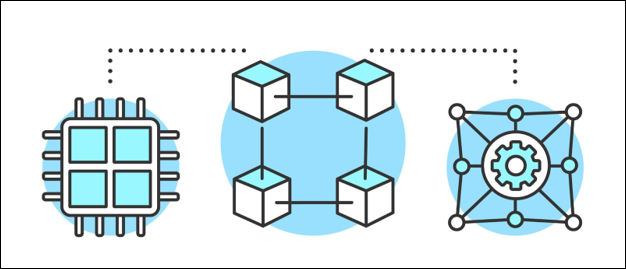In a world where trust is paramount and security is constantly under threat, a new technology emerged over a decade ago that promises to revolutionize how we store and exchange digital information: the blockchain. This is a decentralized ledger system based on cryptography and consensus mechanisms for decentralized operations, and it ensures the integrity and immutability of data. What is blockchain architecture, however?
Blockchain architecture explains how a blockchain functions and the mechanisms in place that keep it decentralized. In this post, we take a shot at understanding blockchain architecture and the intricacies of this fascinating technology.
Table of Contents

So, what is blockchain architecture? Blockchain architecture creates a decentralized ledger system that uses cryptography to ensure the immutability and integrity of digital information. At its core, it is a continuously growing list of records, called blocks, linked together using cryptography to form a chain.
Each block in a chain, as structured by blockchain architecture, contains a batch of verified transactions added to the blockchain in sequential order, creating a permanent and transparent record of all transactions on the network. The decentralized nature of the blockchain architecture means there is no central authority or single point of failure, making it highly secure and resistant to fraud and hacking.
Now that we are well aware of ‘what is blockchain architecture?’, let’s look at its benefits!
A block’s header in a blockchain contains necessary metadata about the block, including its version, timestamp, and the Merkle Root of all the transactions in the block. Nodes use this header to verify the block’s authenticity and contents, ensuring that the data stored on the blockchain is accurate and authentic.
Each block in a blockchain includes a reference to the previous block in the chain through the hash function. This creates an unbreakable link between the blocks in the chain, making it impossible to tamper with any block without changing the hash of every subsequent block. This makes the blockchain highly resistant to fraud and tampering, providing a secure and transparent record of all transactions on the network.
The timestamp in a block’s header provides an accurate and immutable record of when a transaction occurred, making it easy to verify the order of transactions and prevent double spending fraud.
The nonce is a randomly generated number used in the mining process, which is the process by which new blocks get added to a proof-of-work blockchain. By finding a nonce that results in a valid hash for a new block, miners can add new blocks to the blockchain and gain rewards in cryptocurrency. Using a nonce ensures that the mining process is fair and transparent and that no single entity can monopolize the process.
The Merkel Root is a hash of all the transactions within a block, which is included in the block’s header. This hash provides a compact and secure way to verify the contents of the block, making it easy to ensure the authenticity and accuracy of all transactions on the network. Additionally, using a Merkel Tree structure allows for efficient verification of many transactions, making the blockchain scalable and capable of handling large volumes of data.

So what characteristics does a typical blockchain architecture lend the network? Let’s see for ourselves:
The most notable characteristic of a blockchain architecture is the decentralized nature of the chain, meaning a single entity or central authority does not control the network. Instead, the network is distributed across a wide number of nodes throughout the world, each with its own copy of the blockchain. This decentralized architecture makes it nearly impossible for any single party to alter or manipulate the data on the blockchain without the consensus of the majority of nodes on the network, making it highly secure and resistant to hacking or fraud.
Another critical characteristic of blockchain architecture is its persistence. Once a block gets added to the blockchain, it is considered permanent and unalterable. This persistence makes the blockchain ideal for use cases requiring a permanent and auditable data record, such as finance or supply chain management.
Blockchain architecture offers users a high degree of anonymity. While each transaction on the blockchain is public and transparent, users can conduct transactions without revealing their identities, using pseudonyms or digital signatures instead. This anonymity makes the blockchain appealing for use cases where privacy is a concern, such as in digital identity verification or healthcare.
The transparency and persistence of the blockchain make it highly auditable. Any node on the network can view all the transactions on the blockchain, making it easy to verify the authenticity and accuracy of data. Cryptography also ensures that all transactions are secure and tamper-proof, making the blockchain highly trustworthy and reliable for auditing.
Another critical characteristic of blockchain architecture is its transparency. Each transaction on the blockchain is publicly visible to all nodes on the network, creating a highly transparent and trustworthy record of all activities on the web. This transparency makes the blockchain ideal for use cases requiring trust and clarity, such as supply chain management or voting systems.
The use of cryptography is central to blockchain architecture. Cryptography ensures the security and integrity of data on the blockchain, making it tamper-proof and resistant to hacking or fraud. Cryptography is used in various aspects of the blockchain, including the hashing algorithm used to link blocks together, the digital signatures used to authenticate transactions, and the encryption used to secure data on the blockchain.
Blockchain architecture can be divided into a few types, which would be:
A public blockchain is a type of blockchain architecture open to anyone wanting to participate. This means anyone can read, write, or participate in the network as a node, and all transactions are publicly visible on the blockchain.
A private blockchain is a kind of blockchain architecture restricted to a specific group of participants. Unlike public blockchains, access to the network and the ability to approve and record transactions are limited to approved participants. Many organizations and companies may make use of private blockchains in activities like supply chain management or record-keeping for internal purposes.
A consortium blockchain is a kind of blockchain architecture governed by a group of organizations rather than a single entity. In a consortium blockchain, a predefined set of nodes is permitted to write transactions to the blockchain, and all transactions are validated by consensus among the participating nodes. This type of blockchain architecture can provide increased security as compared to private blockchains due to the requirement for consensus among the participating nodes.
The core components of blockchain architecture include:
| Parameter | Blockchain Architecture | Database |
| Data storage | Data is stored in blocks in a distributed ledger. Each block is linked to the earlier block, creating a chain of blocks to ensure data security. | Data is stored in a centralized or distributed database. |
| Security | Blockchain uses cryptography to secure data and transactions. Transactions are immutable and cannot be altered once added to the blockchain. | Databases can be secured with access controls and encryption but are vulnerable to hacking and data breaches. Data can also be altered or deleted. |
| Decentralization | Blockchain is a decentralized system, meaning no single entity controls the network. | Databases can be centralized, with a single entity typically controlling them. |
| Consensus mechanism | Blockchain uses a consensus mechanism to validate transactions and add them to the blockchain. | Databases typically do not have a consensus mechanism. |
| Trust | Blockchain is designed to be trustless, meaning it does not require trust between parties in a transaction. Transactions are validated by the network, not by a trusted third party. | Databases often require trust between involved parties; a trusted third party may validate transactions. |
| Transparency | Blockchain transactions are transparent and visible to all participants on the network. | Databases can be transparent or opaque depending on the access controls and permissions the database owner sets. |
| Performance | Blockchain can be slower and more resource-intensive than traditional databases due to the need for consensus and cryptography. | Databases can be faster and more efficient than blockchain for specific applications. |
In this article, we have tried understanding blockchain architecture as the backbone to a revolutionary technology that provides a decentralized and secure way to store and transfer data. Cryptography and a consensus mechanism are used to validate transactions and uphold the distributed ledger’s integrity.
There are different types/kinds of blockchain architecture, including public, private, and consortium blockchains, each with advantages and disadvantages. While blockchain technology is still in its early stages, it has the potential to transform industries and economies by creating new models of trust and collaboration.
Understanding ;what is blockchain architecture?’ and how blockchain architecture works is essential for anyone interested in exploring this groundbreaking technology’s potential applications and implications.
Blockchain is a decentralized system that uses cryptography and a consensus mechanism to validate transactions and store data in a distributed ledger. It provides a safe and transparent way to record and transfer digital assets without intermediaries.
Blockchain technology is used in various industries and applications, including finance, healthcare, supply chain management, voting systems, etc. For example, cryptocurrencies like Bitcoin and Ethereum use blockchain technology to enable secure and decentralized peer-to-peer transactions.
What is Layer 1 Blockchain | What is a DDoS Attack | What are Soulbound Tokens | Best Blockchain Bridge | Blockchain Beyond Crypto | CBDC Efforts Worldwide | Ordinals NFTs | Ethereum Shanghai Upgrade | What is GameFi | What is Chainlink | Best Crypto Faucet | Blockchain Proof of Work Vs Proof of Stake | What is Phishing and How to Prevent it | Blockchain Layers Explained | Cryptocurrency Liquidity Provider | EVM Wallet Address | Ethereum That Are Compatible With The EVM | Layer 1 Crypto Projects 2022 | What is a Flash Loan Attack | Popular Metaverse Platforms | Cross Chain Ecosystem | Custodial Wallets Vs Non Custodial Wallets | Decentralized Identifiers | Testnet Vs Mainnet | Blockchain Vs API